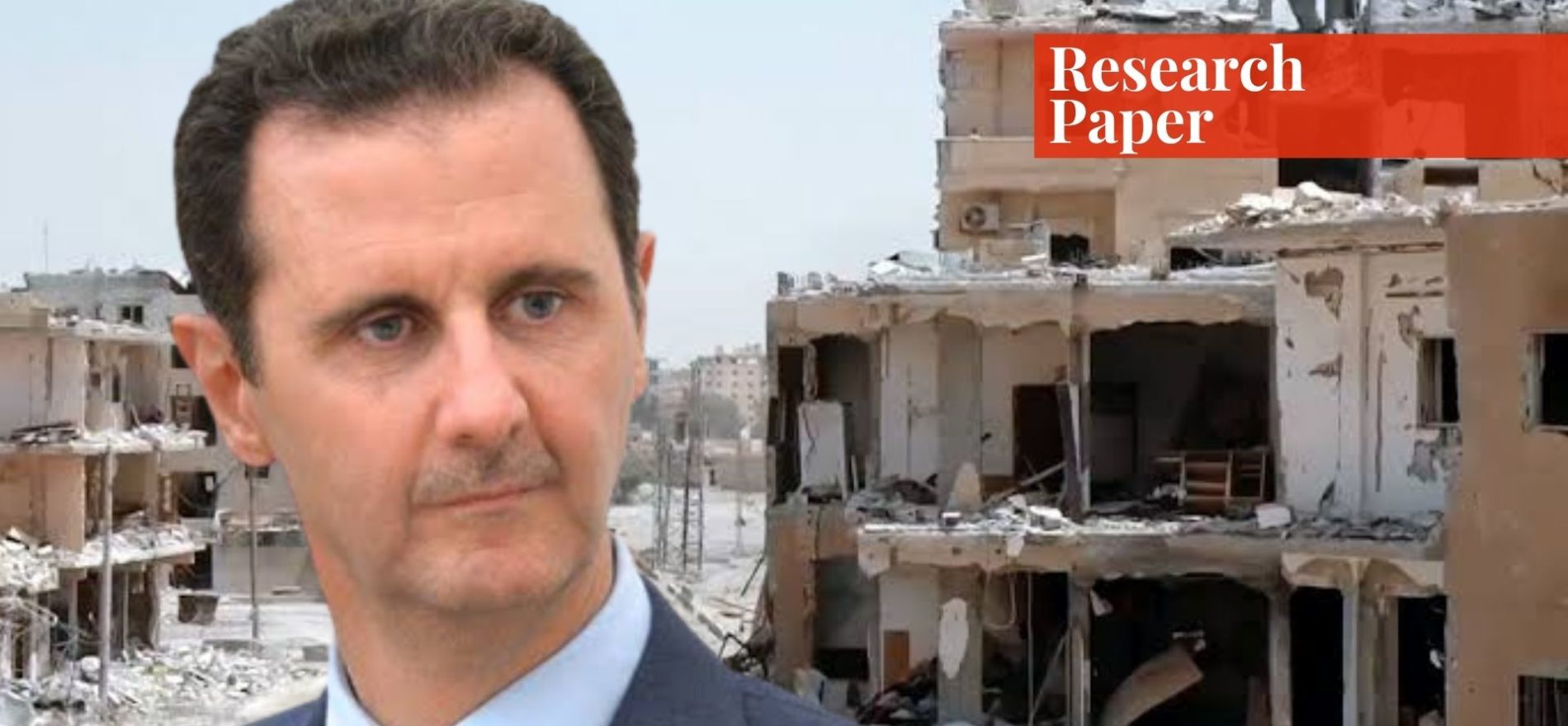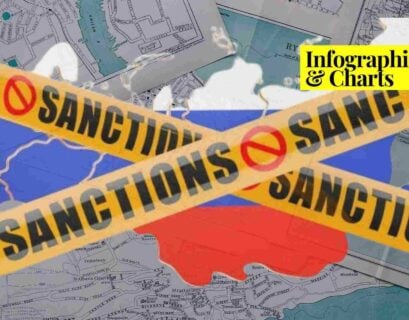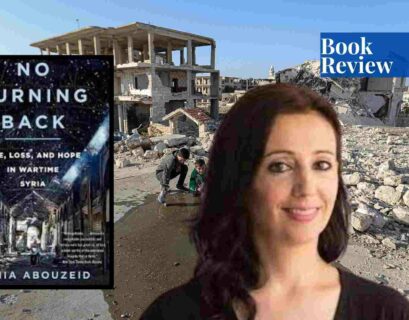Amna Shaukat is currently studying social sciences at National Defence University, Islamabad.
Abstract
The Syrian dictator Hafez al-Assad died in 2000—after thirty years of unpopular one-man rule—and his son, Bashar al-Assad, was elected as the president of Syria. After a brief period of openness and progress known as the Damascus Spring, Bashar al-Assad re-established a powerful and dominating authoritarian system, where civic and public rights were suppressed, readying Syria for a conflict.
The regime was corrupt, marked by nepotism and a bias towards the Shi’ite religion, and as a result, Syria’s Sunni majority was losing support. People were enraged by the state’s oppression of Sunni Muslims. The dictatorship utilized severe force and collective punishment to crush the opposition. People have no means of expressing their concerns.
As a consequence of the Arab Spring, Syrians started revolting against the authoritarian regime of Bashar al-Assad. This paper provides a comprehensive study of the underlying root causes, core problems, and the consequences of the conflict in Syria by employing the conflict tree model.
Introduction
After 400 years under the Ottoman authority and twenty-six years under French rule, the Syrian Arab Republic declared independence in 1946. Between 1958 and 1961, Syria and Egypt were a part of the United Arab Republic, and the fragile Syrian political structure was dissolved (Mousa, 2013). Following a coup in 1970, then-Minister of Defense Lieutenant General Hafez al-Assad seized power, ushering in an era of strong authoritarian government and military domination.
After thirty years of unpopular one-man rule, Hafez al Assad died in 2000, and Bashar al Assad assumed power. He reinstalled where civic and public freedom was shut down (Baczko, Dorronsoro & Quesnay, 2017). After years of mounting discontent and internal tensions, protests against the government grew in intensity in 2011 and swiftly escalated into a civil war.
Syria has been broken by deep ethnic and sectarian divisions, numerous coups and counter-coups, long periods of rule, and the horrific conflict that began in 2011 as a result of the Arab Spring. Since then, Syria has become a violent battleground due to the growing number of parties involved in the conflict, the complexity of the situation on the ground, overlapping and competing interests, and the failure to negotiate permanent and comprehensive peaceful settlements.
Methodology
This paper is based upon qualitative research, which is deductive in nature. The qualitative data is obtained from credible secondary sources, such as official documents, academic studies, articles, and reports.
Analysis
Let’s employ the conflict tree model to visualize the various causes of the conflict in Syria, as well as their resulting effects. By separating cause and effect cleanly, one can link the two with a core problem or key issues.
Roots of the Conflict in Syria
In the conflict tree model, the roots of the tree represent the root causes of a conflict, which are not clearly visible on the surface.
- Colonial Legacy
The colonial legacy is the most significant reason for Syria’s civil war. The European powers – Britain and France – divided Syria. This division impacted the people permanently, causing Syria’s socioeconomic system to be damaged by the colonial powers (Beauchamp, 2015).
- Sectarian Division
The conflict’s origins may be traced further back to the aftermath of World War I, when France and Britain set the borders of Middle Eastern countries, combining many diverse ethnic groups and religions into Syria. Syria’s population is ethnically and religiously divided, with the majority being Sunni Muslims.

The differences between the people from the dominant sects, such as the Shi’ites and Sunnis, were exploited by the international actors. Sunni-dominated states (like Saudi Arabia) were funneling money and troops to the Sunni rebels in Syria. On the other hand, Iran (a Shi’ite Muslim state) was funneling money and troops to Shi’ite rebels in the Middle Eastern state (Zameer, 2021).
Hence, tensions started to build up as a result of this sectarian division. The civil war in Syria has its roots in the Middle East’s long-standing structural rift between the Sunnis and Shi’ites, as well as the power rivalry between Saudi Arabia and Iran (Wimmen, 2018).
- Oppression and Dictatorship
Syria has been under the dictatorial rule since its independence. The regime of Bashar al-Assad was corrupt, characterized by cronyism and a tilt towards the Shi’ite sect. The state oppression of the Sunni Muslims had built up anger among the people. To crush the opposition, the dictatorship used extreme force and collective punishment. It was consequently losing support from Syria’s Sunni majority. Syrians had no way of voicing their dissatisfaction; the system did not allow the existence of opposition forces, let alone a voice in important issues.
- Uneven Economy
The reforms by Bashar al-Asad opened the way to private investment, resulting in an explosion of consumption among the urban upper-middle classes. Privatization, on the other hand, rewarded the wealthy, privileged families with ties to the dictatorship. Meanwhile, provincial Syria, which would ultimately become the epicenter of the rebellion, erupted with rage as living prices skyrocketed, jobs remained scarce, and inequity reigned supreme.
- State Violence
The famous mukhabarat – Syria’s secret police – has infiltrated all aspects of society. Syrians have become apathetic as a result of the fear of the state. State brutality, including disappearances, arbitrary arrests, executions, and general repression, are rampant in Bashar al-Assad’s Syria (Wazir, 2021).
- Population Surge
Syria’s rising population was a ticking time bomb waiting to go off. The country had one of the world’s fastest-growing populations and was listed ninth, among the world’s fastest-growing countries between 2005 and 2010, by the United Nations (Sands, 2011). The inability to manage an increasing population with a faltering economy and a dearth of food, jobs, and schools, led to the Syrian uprising.
Core Problem
The tree’s trunk reflects the core problem to which the conflict is directly linked. The trunk indicates that the existence of this core issue is visible on the conflict’s surface.
- A Violent Power Struggle
Increasing desertions, internal sectarian tensions, and a lack of resources caused the progressive disintegration of the armed forces. The regime resorted increasingly to paramilitary forces and with time, these forces started operating more and more out of the regime’s control. Loyalty started eroding within the state apparatus and the middle layers, especially, jump ship. This sequence of events and the split in the armed and security forces led to a massive escalation of armed clashes and eventually, to a full-blown civil war.
The Trigger of the Conflict in Syria
Triggers are single events, or the anticipation of an event, that can change the intensity or direction of violent conflict. In the case of the Syrian war, the Arab Spring was the main trigger.
- The Arab Spring
The wall of terror in Syria would not have been shattered at this point in history if it had not been for Mohamed Bouazizi, a Tunisian street seller whose self-immolation in December 2010 launched a wave of anti-government protests across the Middle East (NPR, 2011). These protests became widely known as the Arab Spring.
The live broadcast of the fall of the Tunisian and Egyptian regimes on the satellite channel Al Jazeera, in early 2011, inspired millions of Syrians to hope that they, too, could lead their own movement and challenge their autocratic rule of Bashar al-Assad. Even before the Arab Spring-inspired incident, many Syrians were unsatisfied with their government’s incompetence, the people’s lack of liberties, and the general living circumstances in their country, as mentioned in the root causes. Hence, the Arab Spring triggered the conflict.
The Effects of the Syrian War
In the conflict tree model, the tree’s branches symbolize the real-world consequences of the conflict. The effects of the Syrian civil war have been widespread.
- Proxy Wars
Too often, civil wars are misunderstood as a battle between—and only between—two intrastate groups. Indeed, opposing external supporters who deploy local proxies as part of a larger regional, or even global fight, frequently fuel modern civil conflicts. The Syrian conflict has a multiplicity of actors. For instance, the Assad regime’s foreign supporters—Iran, Hezbollah, and Russia—as well as the external supporters of the fractured opposition—mainly Saudi Arabia, Qatar, and Turkey—are fighting in Syria, each with separate proxies (Baylouny, 2020).
- Huge Displacement Crisis
The number of Syrian refugees fleeing the country has surpassed six million, with many trying perilous crossings of the Mediterranean Sea, while another six million people are displaced within Syria (“Civil War in Syria,” n.d.). The conflict has resulted in the largest displacement catastrophe since World War II, leaving millions in desperate need of life-saving humanitarian assistance.

- Worst Healthcare Crisis
Syrians were subjected not just to high levels of violence, but also to the direct repercussions of a defective and worsening healthcare system. Preventable diseases resurfaced as a result of the conflict. Infant mortality has flipped as a result of the widespread destruction of healthcare facilities, infectious diseases have increased, and individuals with chronic disorders have lost access to treatment. Cases of measles among youngsters in Aleppo, as well as the detection of the first case of polio in Syria in 14 years, were early indicators of the country’s failing health system.
- Economic Crisis and Unemployment
Another repercussion of the Syrian civil war is the economic crisis of Syria. Syria – not the strongest trading nation in the Middle East – has created such bad blood not only within itself but also with fellow Middle Eastern countries, and especially with the western countries. This has caused many nations to restrict trade or cut trade ties off with Syria altogether.
In terms of the domestic economy, the civil war has devastated infrastructure, hindered children from attending school, forced the closure of companies, and discouraged general investment and trade. Citizens face high unemployment rates of 57 percent, while Syria’s GDP dropped by a shocking 20.6 percent in 2013, and the economy was so disturbed in 2014 that no formula could produce correct data.
- Worst Humanitarian Crisis
Ten years of humanitarian catastrophe and hostility have had a significant influence on the plight of children in Syria, the region, and abroad. Every Syrian child has been affected by the violence, displacement, severed family relationships, and lack of access to essential services brought about by tremendous physical devastation.

Conclusion
It is all too easy to believe that the solution to Syria’s civil war is simple and obvious. It is easy to believe fixing one minor detail will put the country, as a whole, back on its feet. The Syrian civil war is the outcome of more than just corruption and sectarianism. It is the result of a long chain of historical events that began with the planting of a seed and continued to develop on each other, each one eliciting negative emotions.
The Syrian civil war is the result of historical events such as the French and British colonial control, sectarian strife, and the Assad regime’s authoritarianism. Other concerns that frustrated people under Assad’s administration included a sluggish economy, widespread unemployment, government corruption, and terrible drought. As the world seeks a solution, the answer rests in realizing that the civil war is the outcome of a combination of highly intertwined historical moments, rather than a single event, as analyzed through the conflict tree model in this paper
References
- Baczko, A., Dorronsoro, G., & Quesnay, A. (2017). Civil War in Syria: Mobilization and Competing Social Orders. Cambridge University Press.
- Beauchamp, Z. (2015). Syria’s civil war: a brief history. Vox. https://www.vox.com/2015/9/14/9319293/syrian-refugees-civil-war.
- Baylouny, A.M. (2020). When Blame Backfires: Syrian Refugees and Citizen Grievances in Jordan and Lebanon. Cornell University Press.
- Civil War in Syria. (n.d.). Council on Foreign Relations. https://www.cfr.org/global-conflict-tracker/conflict/conflict-syria.
- Mousa, S. (2013). Commemmorating the United Arab Republic. Al Jazeera. https://www.aljazeera.com/opinions/2013/2/22/commemorating-the-united-arab-republic.
- NPR. (2011). The Arab Spring: A year of revolution. https://www.npr.org/2011/12/17/143897126/the-arab-spring-a-year-of-revolution.
- Sands, P. (2011). Population surge in Syria hampers country’s progress. The National. https://www.thenationalnews.com/world/mena/population-surge-in-syria-hampers-country-s-progress-1.448497
- Wazir, A.K. (2021). State-sponsored terrorism in the Syrian war. Paradigm Shift. https://www.paradigmshift.com.pk/the-syrian-war/
- Wimmen, H. (2018).”The Sectarianization of the Syrian War.” Beyond Sunni and Shia (pp. 61-86).
- Zameer, B. (2021). The civil war in Syria: The role of Iran and Saudi Arabia. Paradigm Shift. https://www.paradigmshift.com.pk/civil-war-in-syria/
If you want to submit your articles, research papers, and book reviews, please check the Submissions page.
The views and opinions expressed in this article/paper are the author’s own and do not necessarily reflect the editorial position of Paradigm Shift.



















